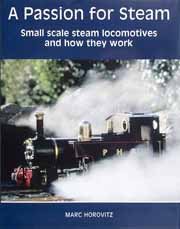
Chapter synopses
The book opens with the author’s personal story with railways. It chronicles his journey in the model-train hobby, his interest in garden railways, and his history with small-scale-live-steam locomotives. It covers the founding of Sidestreet Bannerworks Light Railway Division and GARDEN RAILWAYS magazine, and finishes up with a brief account of his own garden railways.
Chapter 2 -- Basics
In this brief chapter, the basics of how a steam engine works is discussed. Included is the relationship of the fire, the boiler, the piston, the valve, and more.
Chapter 3 -- Cylinders
Different kinds of cylinders are used in small live-steam locomotives. This chapter covers them, from oscillators to D-valve cylinders. You’ll learn how they can be placed on a locomotive and why engines can have anywhere from one to four cylinders. Also covered is the steam cycle in each of the different types.
Chapter 4 -- Pistons and lubricators
As the title suggests, this chapter covers the different variations in pistons, piston rings, and the mechanisms employed to keep them working smoothly.
Chapter 5 -- Reversing mechanisms and valve gears
There are many ways of reversing a steam locomotive. This chapter explains them -- everything from rotary reversing valves to Walschaerts valve gear, and everything in between. Slip eccentrics, slip return cranks, piston-valve reversers, and gear reversing are all covered.
Chapter 6 -- Mechanisms other than traditional
There are lots of ways to get motion out of steam. This chapter talks about all sorts of gear-driven engines, belt-driven engines, overtypes, and more.
Chapter 7 -- Boilers
The boiler is the heart of the steam locomotive. On small-scale steamers they can be as simple as a pot boiler or as complex as a full, locomotive-type boiler. Here, you’ll learn the differences, advantages, and disadvantages of them all, both horizontal and vertical.
Chapter 8 -- Fuels and burners
Almost anything that will burn can be used to make steam, but there are some preferred fuels. Here, those fuels, and how they are best consumed, are covered in depth. Included are alcohol, gas, and coal firing.
Chapter 9 -- Boiler fittings
Some locomotive boilers have no fittings at all, aside from a safety valve. Some are festooned with them. This chapter demystifies all the fittings and describes their function on the locomotive.
Chapter 10 -- Feedwater systems
So how do you get water into the boiler, especially if it is under pressure? There are a variety of different ways, all described in this chapter.
Chapter 11 -- Sundries
This chapter brings together all the odd bits not covered elsewhere in the book. Topics such as running on air; general care and feeding of your locomotive; firing alcohol-, gas-, and coal-fired engines; steaming bays; shipping engines; steam logs; and more are discussed here.
Chapter 12 -- A sampling of steamers
This chapter, which comprises roughly half the book, is a showcase of 80+ small-scale-live-steam locomotive from the author’s collection. Arranged chronologically, this section comprises a vast array of miniature steam technology, ingenuity, and inventiveness. Each engine is examined in depth and is accompanied by a chart of specifications. Engines from private builders as well as commercial models are included in this fascinating compendium.